Challenges of HRM in Overseas Expansion: A Consultancy Report
VerifiedAdded on 2023/01/18
|13
|4240
|56
Report
AI Summary
This consultancy report examines the human resource management (HRM) challenges faced by Li & Fung and Cathay Pacific Airways Limited, two Hong Kong-based companies, as they expand their operations overseas. The report begins with a background of both companies, highlighting their market presence and international growth. It then identifies and analyzes two key HRM issues: staff recruitment and training and development, emphasizing their interconnectedness and significance in international business ventures. The scope of these challenges, their root causes, and the stakeholders impacted are discussed, along with the role of the HR manager in mitigating these issues. A detailed analysis of each challenge is presented, including positive and negative impacts, problem-solving strategies, and areas for improvement. The report provides recommendations, including short-term action plans, their pros and cons, resource requirements, expected outcomes, and stakeholder expectations. The report underscores the importance of adapting to cultural practices and complying with local regulations to ensure the success of training and development initiatives in a global context.
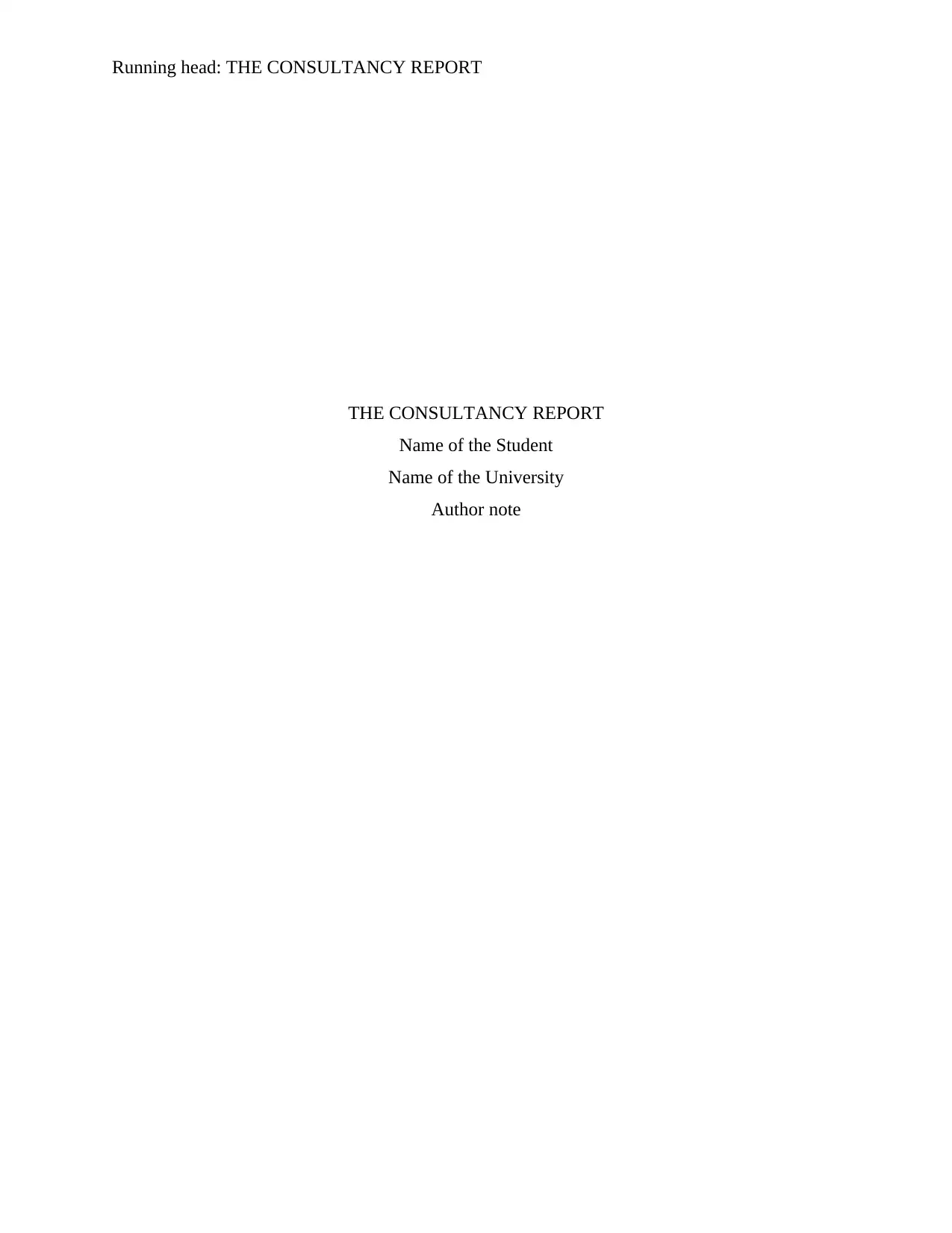
Running head: THE CONSULTANCY REPORT
THE CONSULTANCY REPORT
Name of the Student
Name of the University
Author note
THE CONSULTANCY REPORT
Name of the Student
Name of the University
Author note
Paraphrase This Document
Need a fresh take? Get an instant paraphrase of this document with our AI Paraphraser
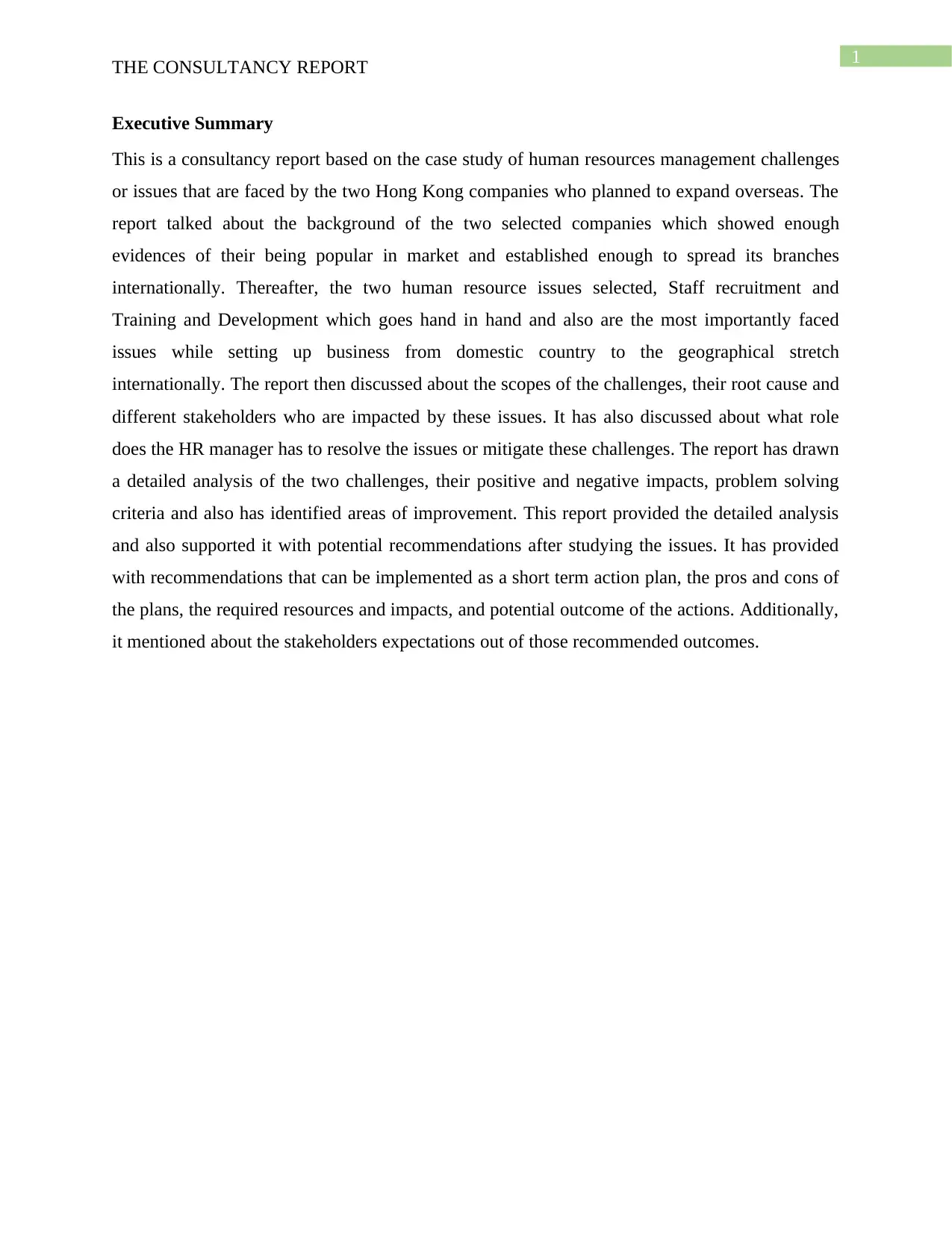
1
THE CONSULTANCY REPORT
Executive Summary
This is a consultancy report based on the case study of human resources management challenges
or issues that are faced by the two Hong Kong companies who planned to expand overseas. The
report talked about the background of the two selected companies which showed enough
evidences of their being popular in market and established enough to spread its branches
internationally. Thereafter, the two human resource issues selected, Staff recruitment and
Training and Development which goes hand in hand and also are the most importantly faced
issues while setting up business from domestic country to the geographical stretch
internationally. The report then discussed about the scopes of the challenges, their root cause and
different stakeholders who are impacted by these issues. It has also discussed about what role
does the HR manager has to resolve the issues or mitigate these challenges. The report has drawn
a detailed analysis of the two challenges, their positive and negative impacts, problem solving
criteria and also has identified areas of improvement. This report provided the detailed analysis
and also supported it with potential recommendations after studying the issues. It has provided
with recommendations that can be implemented as a short term action plan, the pros and cons of
the plans, the required resources and impacts, and potential outcome of the actions. Additionally,
it mentioned about the stakeholders expectations out of those recommended outcomes.
THE CONSULTANCY REPORT
Executive Summary
This is a consultancy report based on the case study of human resources management challenges
or issues that are faced by the two Hong Kong companies who planned to expand overseas. The
report talked about the background of the two selected companies which showed enough
evidences of their being popular in market and established enough to spread its branches
internationally. Thereafter, the two human resource issues selected, Staff recruitment and
Training and Development which goes hand in hand and also are the most importantly faced
issues while setting up business from domestic country to the geographical stretch
internationally. The report then discussed about the scopes of the challenges, their root cause and
different stakeholders who are impacted by these issues. It has also discussed about what role
does the HR manager has to resolve the issues or mitigate these challenges. The report has drawn
a detailed analysis of the two challenges, their positive and negative impacts, problem solving
criteria and also has identified areas of improvement. This report provided the detailed analysis
and also supported it with potential recommendations after studying the issues. It has provided
with recommendations that can be implemented as a short term action plan, the pros and cons of
the plans, the required resources and impacts, and potential outcome of the actions. Additionally,
it mentioned about the stakeholders expectations out of those recommended outcomes.
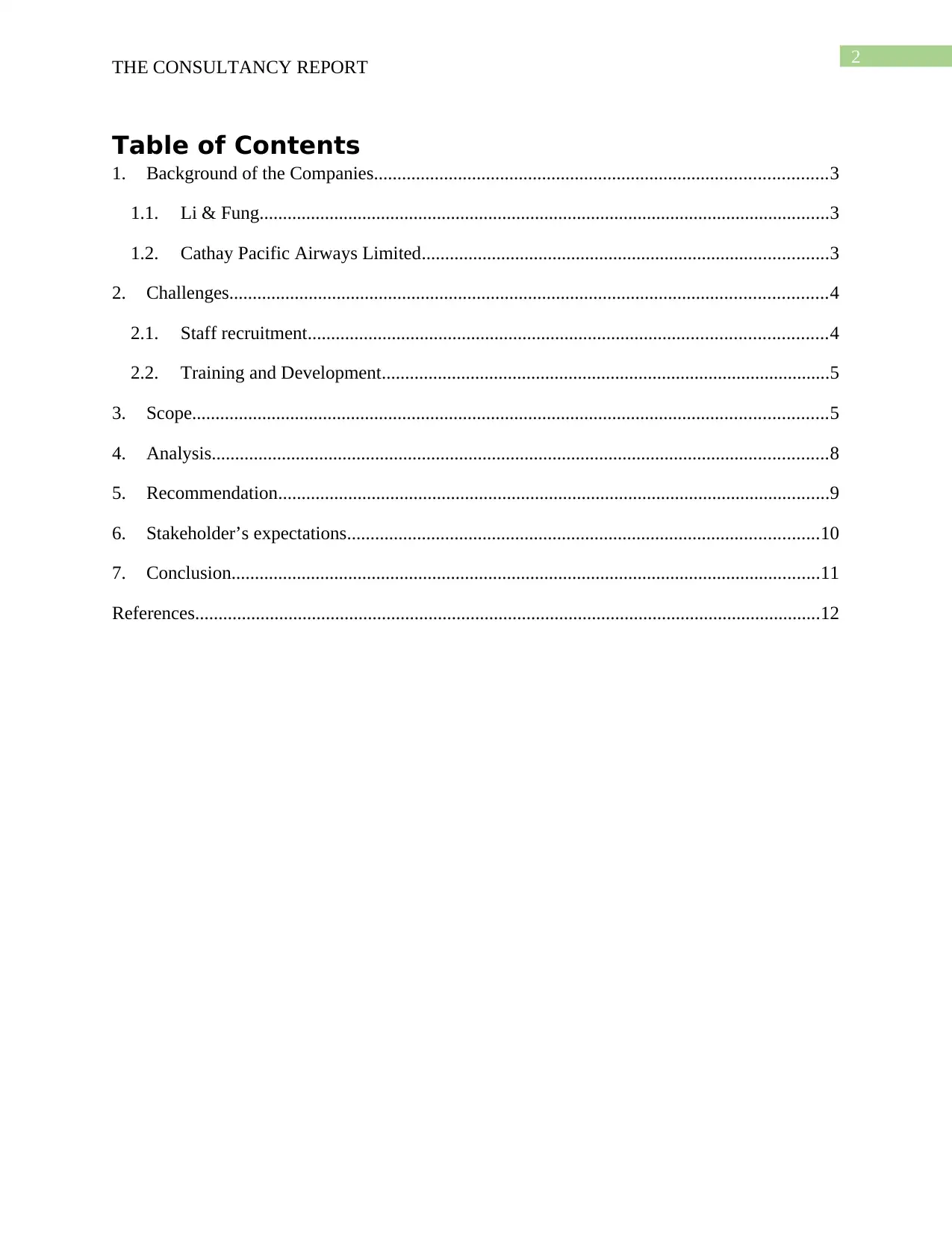
2
THE CONSULTANCY REPORT
Table of Contents
1. Background of the Companies.................................................................................................3
1.1. Li & Fung..........................................................................................................................3
1.2. Cathay Pacific Airways Limited.......................................................................................3
2. Challenges................................................................................................................................4
2.1. Staff recruitment...............................................................................................................4
2.2. Training and Development................................................................................................5
3. Scope........................................................................................................................................5
4. Analysis....................................................................................................................................8
5. Recommendation......................................................................................................................9
6. Stakeholder’s expectations.....................................................................................................10
7. Conclusion..............................................................................................................................11
References......................................................................................................................................12
THE CONSULTANCY REPORT
Table of Contents
1. Background of the Companies.................................................................................................3
1.1. Li & Fung..........................................................................................................................3
1.2. Cathay Pacific Airways Limited.......................................................................................3
2. Challenges................................................................................................................................4
2.1. Staff recruitment...............................................................................................................4
2.2. Training and Development................................................................................................5
3. Scope........................................................................................................................................5
4. Analysis....................................................................................................................................8
5. Recommendation......................................................................................................................9
6. Stakeholder’s expectations.....................................................................................................10
7. Conclusion..............................................................................................................................11
References......................................................................................................................................12
⊘ This is a preview!⊘
Do you want full access?
Subscribe today to unlock all pages.

Trusted by 1+ million students worldwide
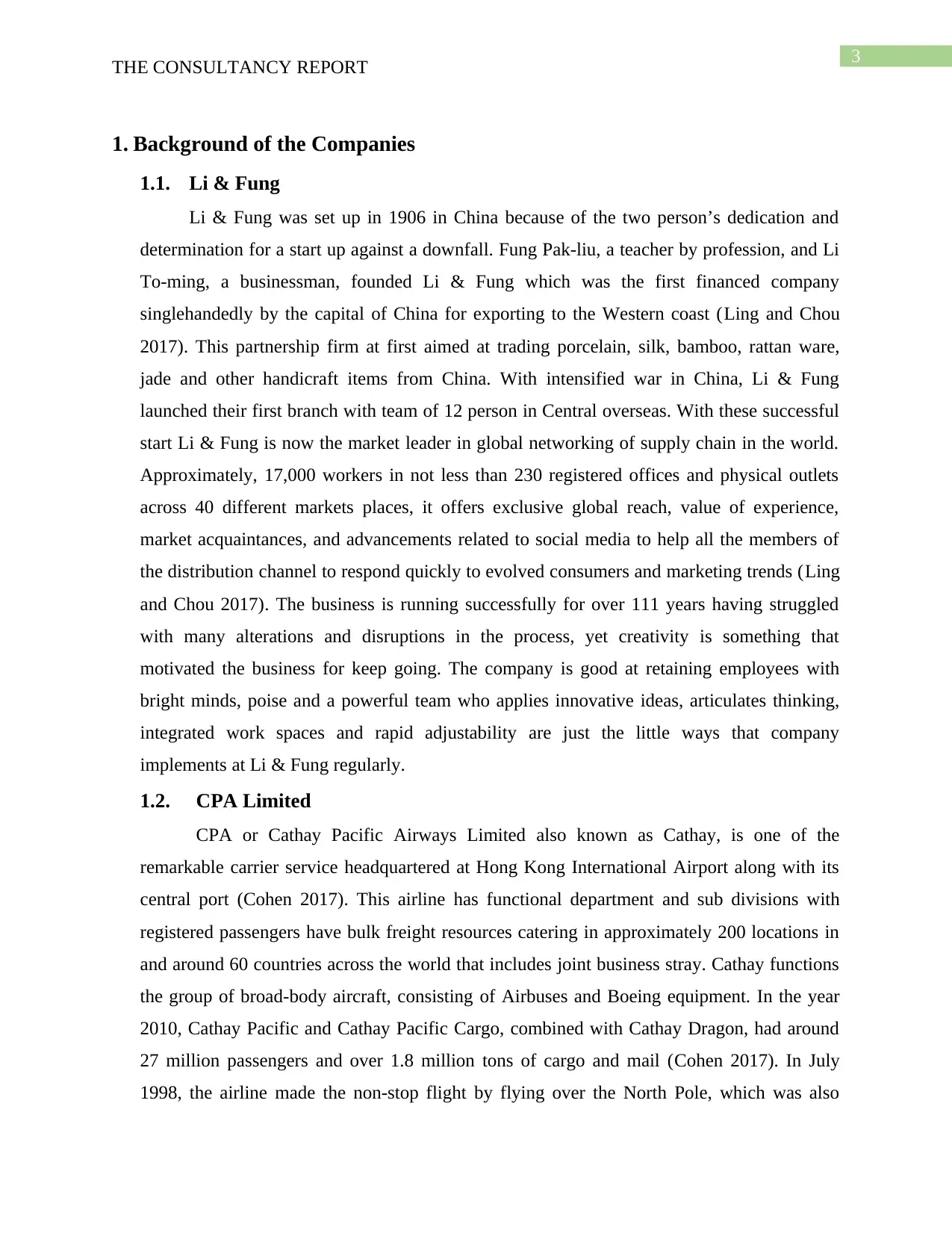
3
THE CONSULTANCY REPORT
1. Background of the Companies
1.1. Li & Fung
Li & Fung was set up in 1906 in China because of the two person’s dedication and
determination for a start up against a downfall. Fung Pak-liu, a teacher by profession, and Li
To-ming, a businessman, founded Li & Fung which was the first financed company
singlehandedly by the capital of China for exporting to the Western coast (Ling and Chou
2017). This partnership firm at first aimed at trading porcelain, silk, bamboo, rattan ware,
jade and other handicraft items from China. With intensified war in China, Li & Fung
launched their first branch with team of 12 person in Central overseas. With these successful
start Li & Fung is now the market leader in global networking of supply chain in the world.
Approximately, 17,000 workers in not less than 230 registered offices and physical outlets
across 40 different markets places, it offers exclusive global reach, value of experience,
market acquaintances, and advancements related to social media to help all the members of
the distribution channel to respond quickly to evolved consumers and marketing trends (Ling
and Chou 2017). The business is running successfully for over 111 years having struggled
with many alterations and disruptions in the process, yet creativity is something that
motivated the business for keep going. The company is good at retaining employees with
bright minds, poise and a powerful team who applies innovative ideas, articulates thinking,
integrated work spaces and rapid adjustability are just the little ways that company
implements at Li & Fung regularly.
1.2. CPA Limited
CPA or Cathay Pacific Airways Limited also known as Cathay, is one of the
remarkable carrier service headquartered at Hong Kong International Airport along with its
central port (Cohen 2017). This airline has functional department and sub divisions with
registered passengers have bulk freight resources catering in approximately 200 locations in
and around 60 countries across the world that includes joint business stray. Cathay functions
the group of broad-body aircraft, consisting of Airbuses and Boeing equipment. In the year
2010, Cathay Pacific and Cathay Pacific Cargo, combined with Cathay Dragon, had around
27 million passengers and over 1.8 million tons of cargo and mail (Cohen 2017). In July
1998, the airline made the non-stop flight by flying over the North Pole, which was also
THE CONSULTANCY REPORT
1. Background of the Companies
1.1. Li & Fung
Li & Fung was set up in 1906 in China because of the two person’s dedication and
determination for a start up against a downfall. Fung Pak-liu, a teacher by profession, and Li
To-ming, a businessman, founded Li & Fung which was the first financed company
singlehandedly by the capital of China for exporting to the Western coast (Ling and Chou
2017). This partnership firm at first aimed at trading porcelain, silk, bamboo, rattan ware,
jade and other handicraft items from China. With intensified war in China, Li & Fung
launched their first branch with team of 12 person in Central overseas. With these successful
start Li & Fung is now the market leader in global networking of supply chain in the world.
Approximately, 17,000 workers in not less than 230 registered offices and physical outlets
across 40 different markets places, it offers exclusive global reach, value of experience,
market acquaintances, and advancements related to social media to help all the members of
the distribution channel to respond quickly to evolved consumers and marketing trends (Ling
and Chou 2017). The business is running successfully for over 111 years having struggled
with many alterations and disruptions in the process, yet creativity is something that
motivated the business for keep going. The company is good at retaining employees with
bright minds, poise and a powerful team who applies innovative ideas, articulates thinking,
integrated work spaces and rapid adjustability are just the little ways that company
implements at Li & Fung regularly.
1.2. CPA Limited
CPA or Cathay Pacific Airways Limited also known as Cathay, is one of the
remarkable carrier service headquartered at Hong Kong International Airport along with its
central port (Cohen 2017). This airline has functional department and sub divisions with
registered passengers have bulk freight resources catering in approximately 200 locations in
and around 60 countries across the world that includes joint business stray. Cathay functions
the group of broad-body aircraft, consisting of Airbuses and Boeing equipment. In the year
2010, Cathay Pacific and Cathay Pacific Cargo, combined with Cathay Dragon, had around
27 million passengers and over 1.8 million tons of cargo and mail (Cohen 2017). In July
1998, the airline made the non-stop flight by flying over the North Pole, which was also
Paraphrase This Document
Need a fresh take? Get an instant paraphrase of this document with our AI Paraphraser
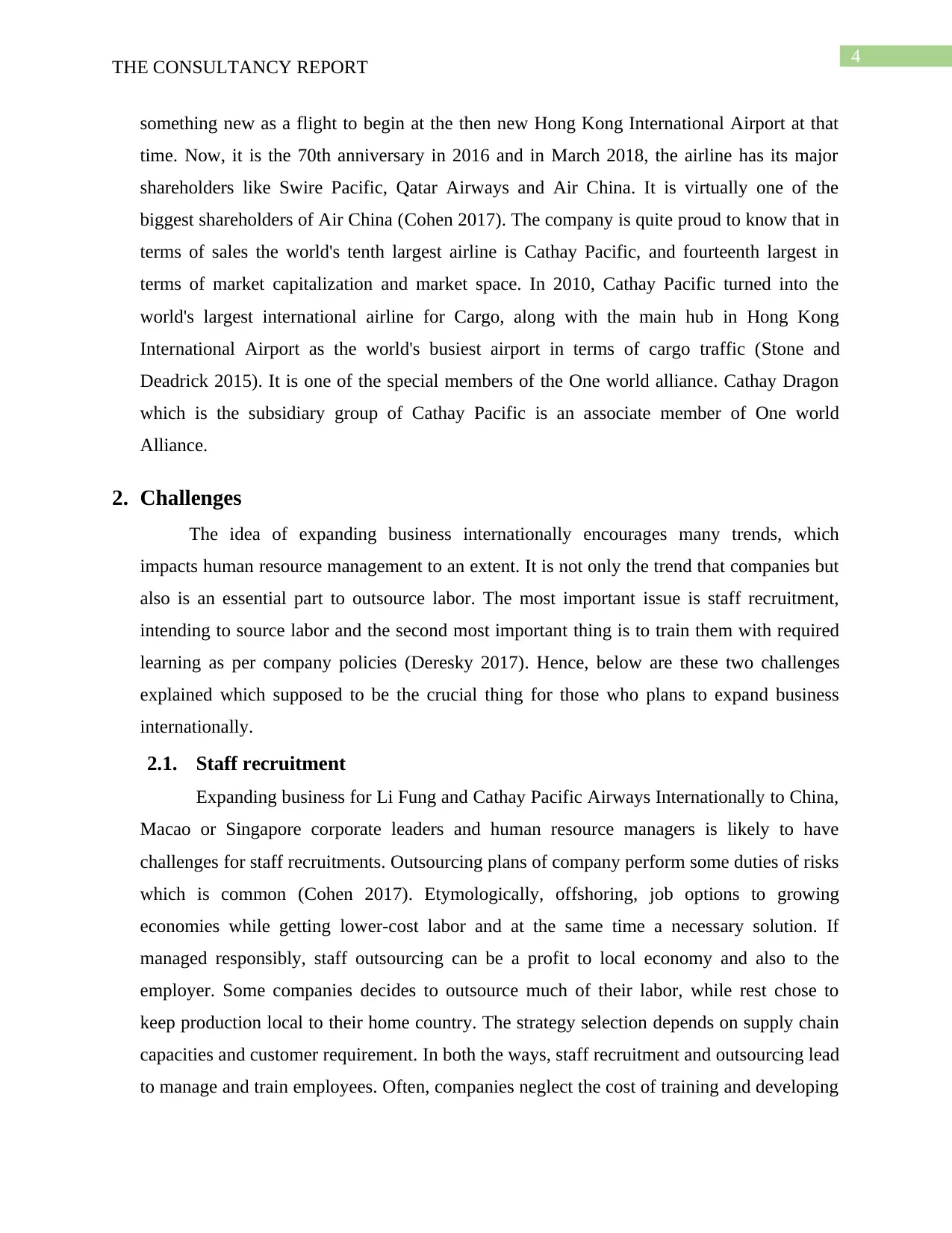
4
THE CONSULTANCY REPORT
something new as a flight to begin at the then new Hong Kong International Airport at that
time. Now, it is the 70th anniversary in 2016 and in March 2018, the airline has its major
shareholders like Swire Pacific, Qatar Airways and Air China. It is virtually one of the
biggest shareholders of Air China (Cohen 2017). The company is quite proud to know that in
terms of sales the world's tenth largest airline is Cathay Pacific, and fourteenth largest in
terms of market capitalization and market space. In 2010, Cathay Pacific turned into the
world's largest international airline for Cargo, along with the main hub in Hong Kong
International Airport as the world's busiest airport in terms of cargo traffic (Stone and
Deadrick 2015). It is one of the special members of the One world alliance. Cathay Dragon
which is the subsidiary group of Cathay Pacific is an associate member of One world
Alliance.
2. Challenges
The idea of expanding business internationally encourages many trends, which
impacts human resource management to an extent. It is not only the trend that companies but
also is an essential part to outsource labor. The most important issue is staff recruitment,
intending to source labor and the second most important thing is to train them with required
learning as per company policies (Deresky 2017). Hence, below are these two challenges
explained which supposed to be the crucial thing for those who plans to expand business
internationally.
2.1. Staff recruitment
Expanding business for Li Fung and Cathay Pacific Airways Internationally to China,
Macao or Singapore corporate leaders and human resource managers is likely to have
challenges for staff recruitments. Outsourcing plans of company perform some duties of risks
which is common (Cohen 2017). Etymologically, offshoring, job options to growing
economies while getting lower-cost labor and at the same time a necessary solution. If
managed responsibly, staff outsourcing can be a profit to local economy and also to the
employer. Some companies decides to outsource much of their labor, while rest chose to
keep production local to their home country. The strategy selection depends on supply chain
capacities and customer requirement. In both the ways, staff recruitment and outsourcing lead
to manage and train employees. Often, companies neglect the cost of training and developing
THE CONSULTANCY REPORT
something new as a flight to begin at the then new Hong Kong International Airport at that
time. Now, it is the 70th anniversary in 2016 and in March 2018, the airline has its major
shareholders like Swire Pacific, Qatar Airways and Air China. It is virtually one of the
biggest shareholders of Air China (Cohen 2017). The company is quite proud to know that in
terms of sales the world's tenth largest airline is Cathay Pacific, and fourteenth largest in
terms of market capitalization and market space. In 2010, Cathay Pacific turned into the
world's largest international airline for Cargo, along with the main hub in Hong Kong
International Airport as the world's busiest airport in terms of cargo traffic (Stone and
Deadrick 2015). It is one of the special members of the One world alliance. Cathay Dragon
which is the subsidiary group of Cathay Pacific is an associate member of One world
Alliance.
2. Challenges
The idea of expanding business internationally encourages many trends, which
impacts human resource management to an extent. It is not only the trend that companies but
also is an essential part to outsource labor. The most important issue is staff recruitment,
intending to source labor and the second most important thing is to train them with required
learning as per company policies (Deresky 2017). Hence, below are these two challenges
explained which supposed to be the crucial thing for those who plans to expand business
internationally.
2.1. Staff recruitment
Expanding business for Li Fung and Cathay Pacific Airways Internationally to China,
Macao or Singapore corporate leaders and human resource managers is likely to have
challenges for staff recruitments. Outsourcing plans of company perform some duties of risks
which is common (Cohen 2017). Etymologically, offshoring, job options to growing
economies while getting lower-cost labor and at the same time a necessary solution. If
managed responsibly, staff outsourcing can be a profit to local economy and also to the
employer. Some companies decides to outsource much of their labor, while rest chose to
keep production local to their home country. The strategy selection depends on supply chain
capacities and customer requirement. In both the ways, staff recruitment and outsourcing lead
to manage and train employees. Often, companies neglect the cost of training and developing
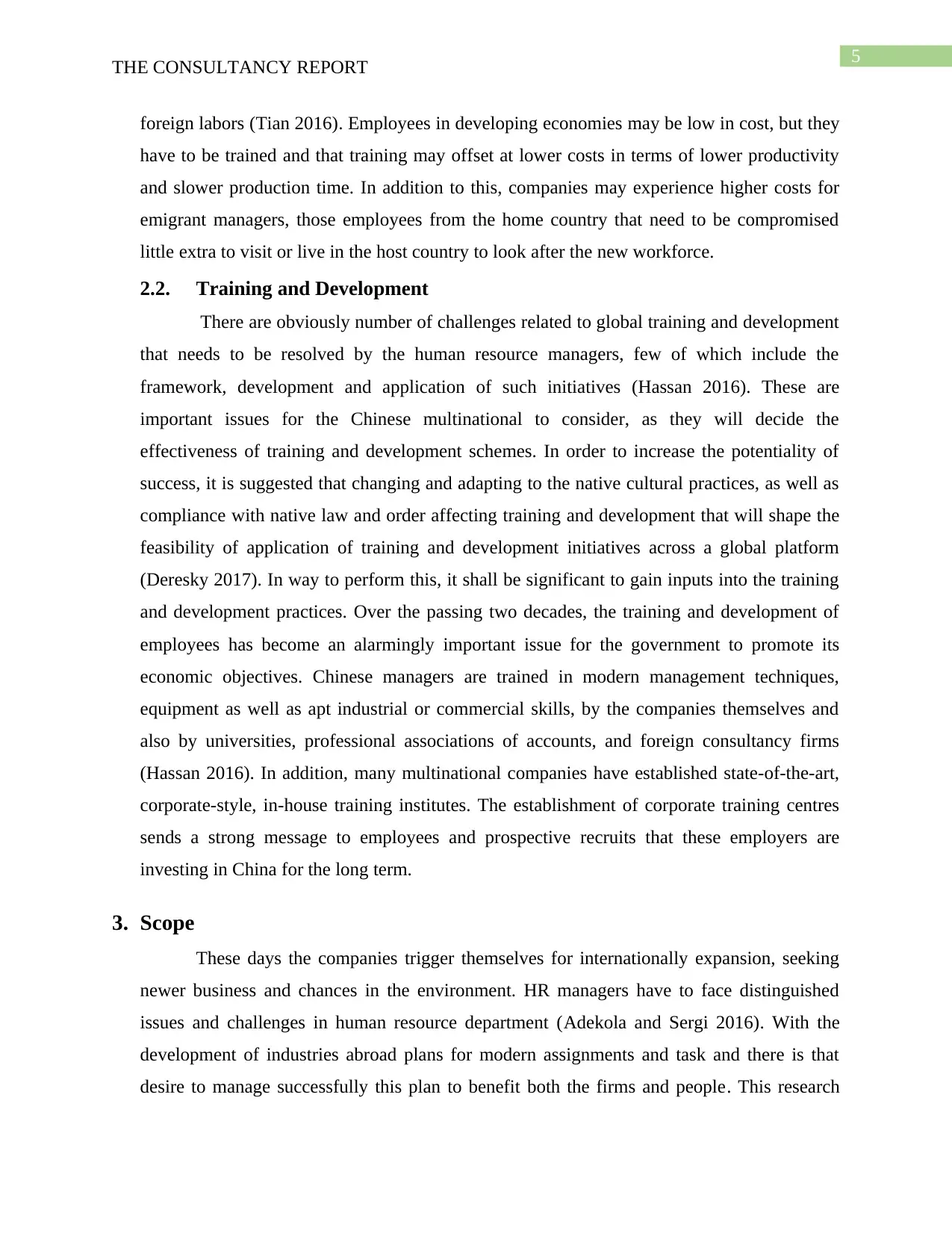
5
THE CONSULTANCY REPORT
foreign labors (Tian 2016). Employees in developing economies may be low in cost, but they
have to be trained and that training may offset at lower costs in terms of lower productivity
and slower production time. In addition to this, companies may experience higher costs for
emigrant managers, those employees from the home country that need to be compromised
little extra to visit or live in the host country to look after the new workforce.
2.2. Training and Development
There are obviously number of challenges related to global training and development
that needs to be resolved by the human resource managers, few of which include the
framework, development and application of such initiatives (Hassan 2016). These are
important issues for the Chinese multinational to consider, as they will decide the
effectiveness of training and development schemes. In order to increase the potentiality of
success, it is suggested that changing and adapting to the native cultural practices, as well as
compliance with native law and order affecting training and development that will shape the
feasibility of application of training and development initiatives across a global platform
(Deresky 2017). In way to perform this, it shall be significant to gain inputs into the training
and development practices. Over the passing two decades, the training and development of
employees has become an alarmingly important issue for the government to promote its
economic objectives. Chinese managers are trained in modern management techniques,
equipment as well as apt industrial or commercial skills, by the companies themselves and
also by universities, professional associations of accounts, and foreign consultancy firms
(Hassan 2016). In addition, many multinational companies have established state-of-the-art,
corporate-style, in-house training institutes. The establishment of corporate training centres
sends a strong message to employees and prospective recruits that these employers are
investing in China for the long term.
3. Scope
These days the companies trigger themselves for internationally expansion, seeking
newer business and chances in the environment. HR managers have to face distinguished
issues and challenges in human resource department (Adekola and Sergi 2016). With the
development of industries abroad plans for modern assignments and task and there is that
desire to manage successfully this plan to benefit both the firms and people. This research
THE CONSULTANCY REPORT
foreign labors (Tian 2016). Employees in developing economies may be low in cost, but they
have to be trained and that training may offset at lower costs in terms of lower productivity
and slower production time. In addition to this, companies may experience higher costs for
emigrant managers, those employees from the home country that need to be compromised
little extra to visit or live in the host country to look after the new workforce.
2.2. Training and Development
There are obviously number of challenges related to global training and development
that needs to be resolved by the human resource managers, few of which include the
framework, development and application of such initiatives (Hassan 2016). These are
important issues for the Chinese multinational to consider, as they will decide the
effectiveness of training and development schemes. In order to increase the potentiality of
success, it is suggested that changing and adapting to the native cultural practices, as well as
compliance with native law and order affecting training and development that will shape the
feasibility of application of training and development initiatives across a global platform
(Deresky 2017). In way to perform this, it shall be significant to gain inputs into the training
and development practices. Over the passing two decades, the training and development of
employees has become an alarmingly important issue for the government to promote its
economic objectives. Chinese managers are trained in modern management techniques,
equipment as well as apt industrial or commercial skills, by the companies themselves and
also by universities, professional associations of accounts, and foreign consultancy firms
(Hassan 2016). In addition, many multinational companies have established state-of-the-art,
corporate-style, in-house training institutes. The establishment of corporate training centres
sends a strong message to employees and prospective recruits that these employers are
investing in China for the long term.
3. Scope
These days the companies trigger themselves for internationally expansion, seeking
newer business and chances in the environment. HR managers have to face distinguished
issues and challenges in human resource department (Adekola and Sergi 2016). With the
development of industries abroad plans for modern assignments and task and there is that
desire to manage successfully this plan to benefit both the firms and people. This research
⊘ This is a preview!⊘
Do you want full access?
Subscribe today to unlock all pages.

Trusted by 1+ million students worldwide
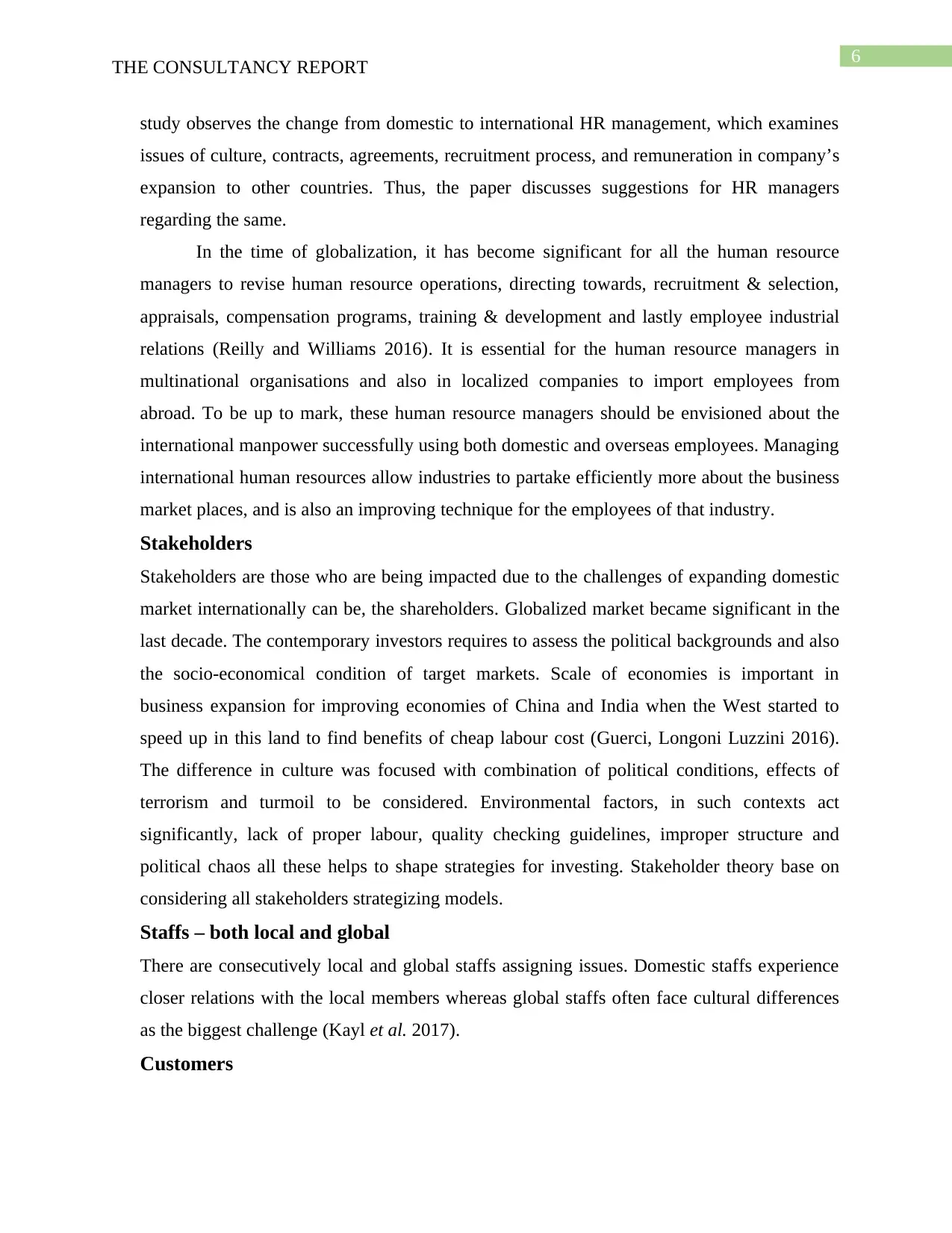
6
THE CONSULTANCY REPORT
study observes the change from domestic to international HR management, which examines
issues of culture, contracts, agreements, recruitment process, and remuneration in company’s
expansion to other countries. Thus, the paper discusses suggestions for HR managers
regarding the same.
In the time of globalization, it has become significant for all the human resource
managers to revise human resource operations, directing towards, recruitment & selection,
appraisals, compensation programs, training & development and lastly employee industrial
relations (Reilly and Williams 2016). It is essential for the human resource managers in
multinational organisations and also in localized companies to import employees from
abroad. To be up to mark, these human resource managers should be envisioned about the
international manpower successfully using both domestic and overseas employees. Managing
international human resources allow industries to partake efficiently more about the business
market places, and is also an improving technique for the employees of that industry.
Stakeholders
Stakeholders are those who are being impacted due to the challenges of expanding domestic
market internationally can be, the shareholders. Globalized market became significant in the
last decade. The contemporary investors requires to assess the political backgrounds and also
the socio-economical condition of target markets. Scale of economies is important in
business expansion for improving economies of China and India when the West started to
speed up in this land to find benefits of cheap labour cost (Guerci, Longoni Luzzini 2016).
The difference in culture was focused with combination of political conditions, effects of
terrorism and turmoil to be considered. Environmental factors, in such contexts act
significantly, lack of proper labour, quality checking guidelines, improper structure and
political chaos all these helps to shape strategies for investing. Stakeholder theory base on
considering all stakeholders strategizing models.
Staffs – both local and global
There are consecutively local and global staffs assigning issues. Domestic staffs experience
closer relations with the local members whereas global staffs often face cultural differences
as the biggest challenge (Kayl et al. 2017).
Customers
THE CONSULTANCY REPORT
study observes the change from domestic to international HR management, which examines
issues of culture, contracts, agreements, recruitment process, and remuneration in company’s
expansion to other countries. Thus, the paper discusses suggestions for HR managers
regarding the same.
In the time of globalization, it has become significant for all the human resource
managers to revise human resource operations, directing towards, recruitment & selection,
appraisals, compensation programs, training & development and lastly employee industrial
relations (Reilly and Williams 2016). It is essential for the human resource managers in
multinational organisations and also in localized companies to import employees from
abroad. To be up to mark, these human resource managers should be envisioned about the
international manpower successfully using both domestic and overseas employees. Managing
international human resources allow industries to partake efficiently more about the business
market places, and is also an improving technique for the employees of that industry.
Stakeholders
Stakeholders are those who are being impacted due to the challenges of expanding domestic
market internationally can be, the shareholders. Globalized market became significant in the
last decade. The contemporary investors requires to assess the political backgrounds and also
the socio-economical condition of target markets. Scale of economies is important in
business expansion for improving economies of China and India when the West started to
speed up in this land to find benefits of cheap labour cost (Guerci, Longoni Luzzini 2016).
The difference in culture was focused with combination of political conditions, effects of
terrorism and turmoil to be considered. Environmental factors, in such contexts act
significantly, lack of proper labour, quality checking guidelines, improper structure and
political chaos all these helps to shape strategies for investing. Stakeholder theory base on
considering all stakeholders strategizing models.
Staffs – both local and global
There are consecutively local and global staffs assigning issues. Domestic staffs experience
closer relations with the local members whereas global staffs often face cultural differences
as the biggest challenge (Kayl et al. 2017).
Customers
Paraphrase This Document
Need a fresh take? Get an instant paraphrase of this document with our AI Paraphraser
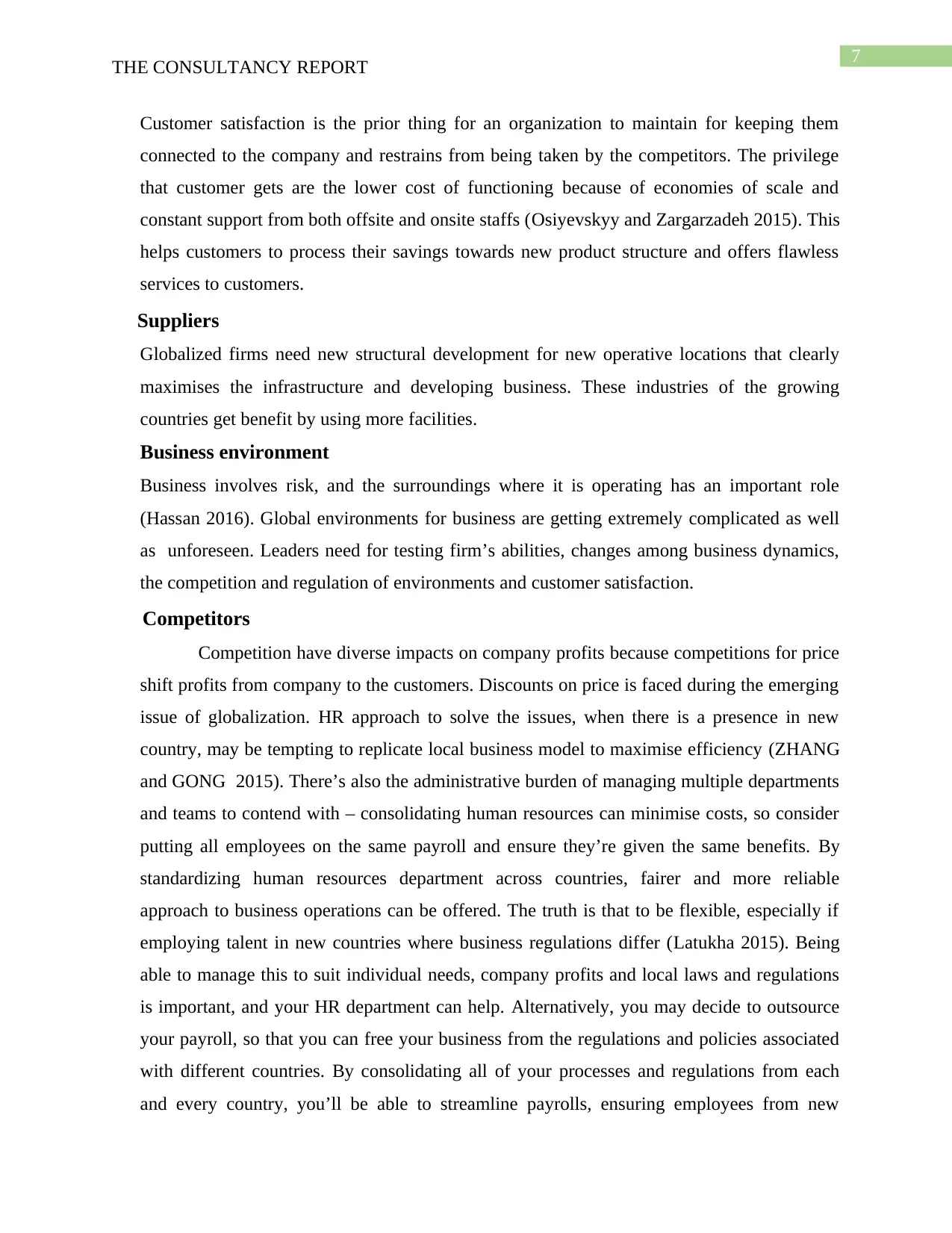
7
THE CONSULTANCY REPORT
Customer satisfaction is the prior thing for an organization to maintain for keeping them
connected to the company and restrains from being taken by the competitors. The privilege
that customer gets are the lower cost of functioning because of economies of scale and
constant support from both offsite and onsite staffs (Osiyevskyy and Zargarzadeh 2015). This
helps customers to process their savings towards new product structure and offers flawless
services to customers.
Suppliers
Globalized firms need new structural development for new operative locations that clearly
maximises the infrastructure and developing business. These industries of the growing
countries get benefit by using more facilities.
Business environment
Business involves risk, and the surroundings where it is operating has an important role
(Hassan 2016). Global environments for business are getting extremely complicated as well
as unforeseen. Leaders need for testing firm’s abilities, changes among business dynamics,
the competition and regulation of environments and customer satisfaction.
Competitors
Competition have diverse impacts on company profits because competitions for price
shift profits from company to the customers. Discounts on price is faced during the emerging
issue of globalization. HR approach to solve the issues, when there is a presence in new
country, may be tempting to replicate local business model to maximise efficiency (ZHANG
and GONG 2015). There’s also the administrative burden of managing multiple departments
and teams to contend with – consolidating human resources can minimise costs, so consider
putting all employees on the same payroll and ensure they’re given the same benefits. By
standardizing human resources department across countries, fairer and more reliable
approach to business operations can be offered. The truth is that to be flexible, especially if
employing talent in new countries where business regulations differ (Latukha 2015). Being
able to manage this to suit individual needs, company profits and local laws and regulations
is important, and your HR department can help. Alternatively, you may decide to outsource
your payroll, so that you can free your business from the regulations and policies associated
with different countries. By consolidating all of your processes and regulations from each
and every country, you’ll be able to streamline payrolls, ensuring employees from new
THE CONSULTANCY REPORT
Customer satisfaction is the prior thing for an organization to maintain for keeping them
connected to the company and restrains from being taken by the competitors. The privilege
that customer gets are the lower cost of functioning because of economies of scale and
constant support from both offsite and onsite staffs (Osiyevskyy and Zargarzadeh 2015). This
helps customers to process their savings towards new product structure and offers flawless
services to customers.
Suppliers
Globalized firms need new structural development for new operative locations that clearly
maximises the infrastructure and developing business. These industries of the growing
countries get benefit by using more facilities.
Business environment
Business involves risk, and the surroundings where it is operating has an important role
(Hassan 2016). Global environments for business are getting extremely complicated as well
as unforeseen. Leaders need for testing firm’s abilities, changes among business dynamics,
the competition and regulation of environments and customer satisfaction.
Competitors
Competition have diverse impacts on company profits because competitions for price
shift profits from company to the customers. Discounts on price is faced during the emerging
issue of globalization. HR approach to solve the issues, when there is a presence in new
country, may be tempting to replicate local business model to maximise efficiency (ZHANG
and GONG 2015). There’s also the administrative burden of managing multiple departments
and teams to contend with – consolidating human resources can minimise costs, so consider
putting all employees on the same payroll and ensure they’re given the same benefits. By
standardizing human resources department across countries, fairer and more reliable
approach to business operations can be offered. The truth is that to be flexible, especially if
employing talent in new countries where business regulations differ (Latukha 2015). Being
able to manage this to suit individual needs, company profits and local laws and regulations
is important, and your HR department can help. Alternatively, you may decide to outsource
your payroll, so that you can free your business from the regulations and policies associated
with different countries. By consolidating all of your processes and regulations from each
and every country, you’ll be able to streamline payrolls, ensuring employees from new
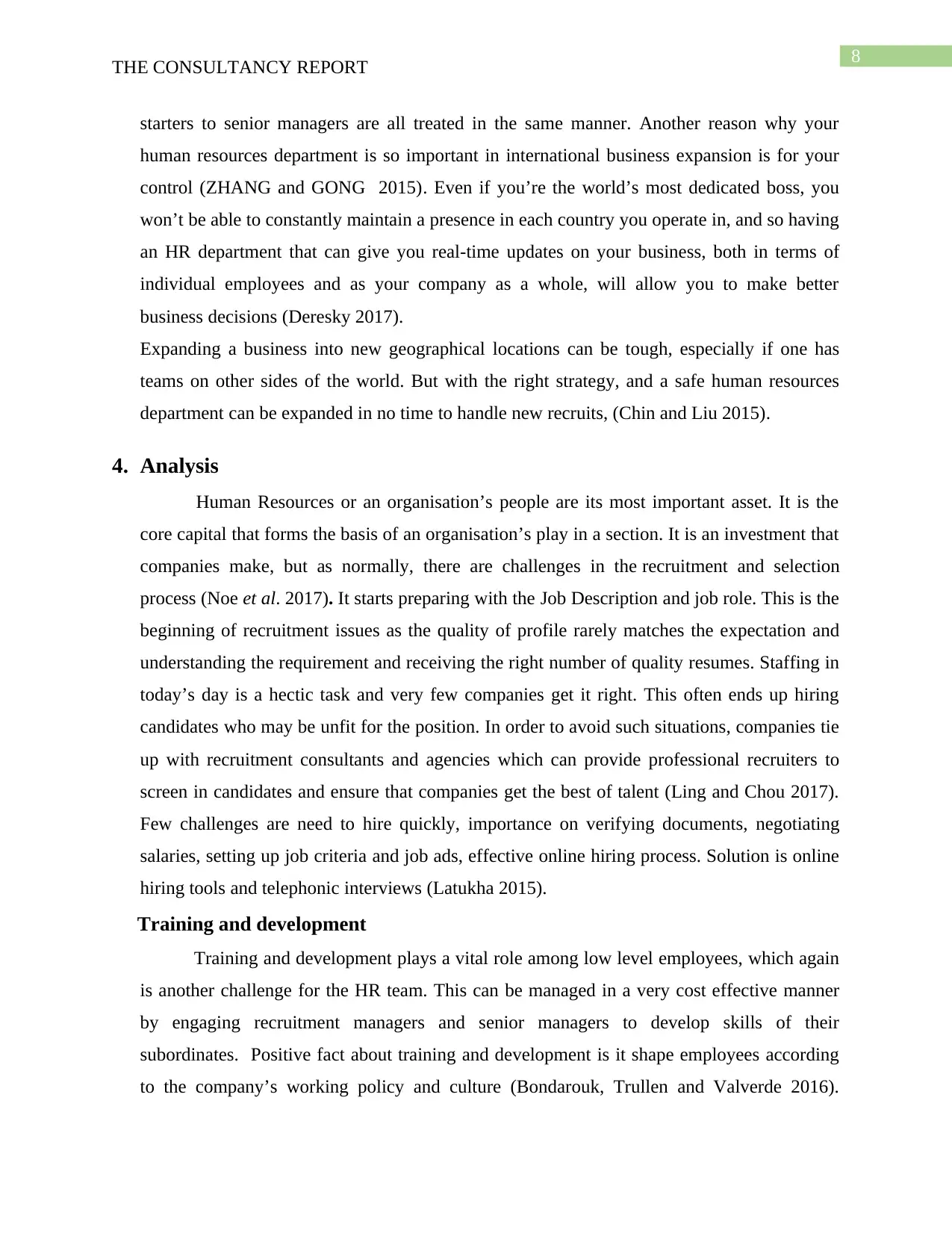
8
THE CONSULTANCY REPORT
starters to senior managers are all treated in the same manner. Another reason why your
human resources department is so important in international business expansion is for your
control (ZHANG and GONG 2015). Even if you’re the world’s most dedicated boss, you
won’t be able to constantly maintain a presence in each country you operate in, and so having
an HR department that can give you real-time updates on your business, both in terms of
individual employees and as your company as a whole, will allow you to make better
business decisions (Deresky 2017).
Expanding a business into new geographical locations can be tough, especially if one has
teams on other sides of the world. But with the right strategy, and a safe human resources
department can be expanded in no time to handle new recruits, (Chin and Liu 2015).
4. Analysis
Human Resources or an organisation’s people are its most important asset. It is the
core capital that forms the basis of an organisation’s play in a section. It is an investment that
companies make, but as normally, there are challenges in the recruitment and selection
process (Noe et al. 2017). It starts preparing with the Job Description and job role. This is the
beginning of recruitment issues as the quality of profile rarely matches the expectation and
understanding the requirement and receiving the right number of quality resumes. Staffing in
today’s day is a hectic task and very few companies get it right. This often ends up hiring
candidates who may be unfit for the position. In order to avoid such situations, companies tie
up with recruitment consultants and agencies which can provide professional recruiters to
screen in candidates and ensure that companies get the best of talent (Ling and Chou 2017).
Few challenges are need to hire quickly, importance on verifying documents, negotiating
salaries, setting up job criteria and job ads, effective online hiring process. Solution is online
hiring tools and telephonic interviews (Latukha 2015).
Training and development
Training and development plays a vital role among low level employees, which again
is another challenge for the HR team. This can be managed in a very cost effective manner
by engaging recruitment managers and senior managers to develop skills of their
subordinates. Positive fact about training and development is it shape employees according
to the company’s working policy and culture (Bondarouk, Trullen and Valverde 2016).
THE CONSULTANCY REPORT
starters to senior managers are all treated in the same manner. Another reason why your
human resources department is so important in international business expansion is for your
control (ZHANG and GONG 2015). Even if you’re the world’s most dedicated boss, you
won’t be able to constantly maintain a presence in each country you operate in, and so having
an HR department that can give you real-time updates on your business, both in terms of
individual employees and as your company as a whole, will allow you to make better
business decisions (Deresky 2017).
Expanding a business into new geographical locations can be tough, especially if one has
teams on other sides of the world. But with the right strategy, and a safe human resources
department can be expanded in no time to handle new recruits, (Chin and Liu 2015).
4. Analysis
Human Resources or an organisation’s people are its most important asset. It is the
core capital that forms the basis of an organisation’s play in a section. It is an investment that
companies make, but as normally, there are challenges in the recruitment and selection
process (Noe et al. 2017). It starts preparing with the Job Description and job role. This is the
beginning of recruitment issues as the quality of profile rarely matches the expectation and
understanding the requirement and receiving the right number of quality resumes. Staffing in
today’s day is a hectic task and very few companies get it right. This often ends up hiring
candidates who may be unfit for the position. In order to avoid such situations, companies tie
up with recruitment consultants and agencies which can provide professional recruiters to
screen in candidates and ensure that companies get the best of talent (Ling and Chou 2017).
Few challenges are need to hire quickly, importance on verifying documents, negotiating
salaries, setting up job criteria and job ads, effective online hiring process. Solution is online
hiring tools and telephonic interviews (Latukha 2015).
Training and development
Training and development plays a vital role among low level employees, which again
is another challenge for the HR team. This can be managed in a very cost effective manner
by engaging recruitment managers and senior managers to develop skills of their
subordinates. Positive fact about training and development is it shape employees according
to the company’s working policy and culture (Bondarouk, Trullen and Valverde 2016).
⊘ This is a preview!⊘
Do you want full access?
Subscribe today to unlock all pages.

Trusted by 1+ million students worldwide
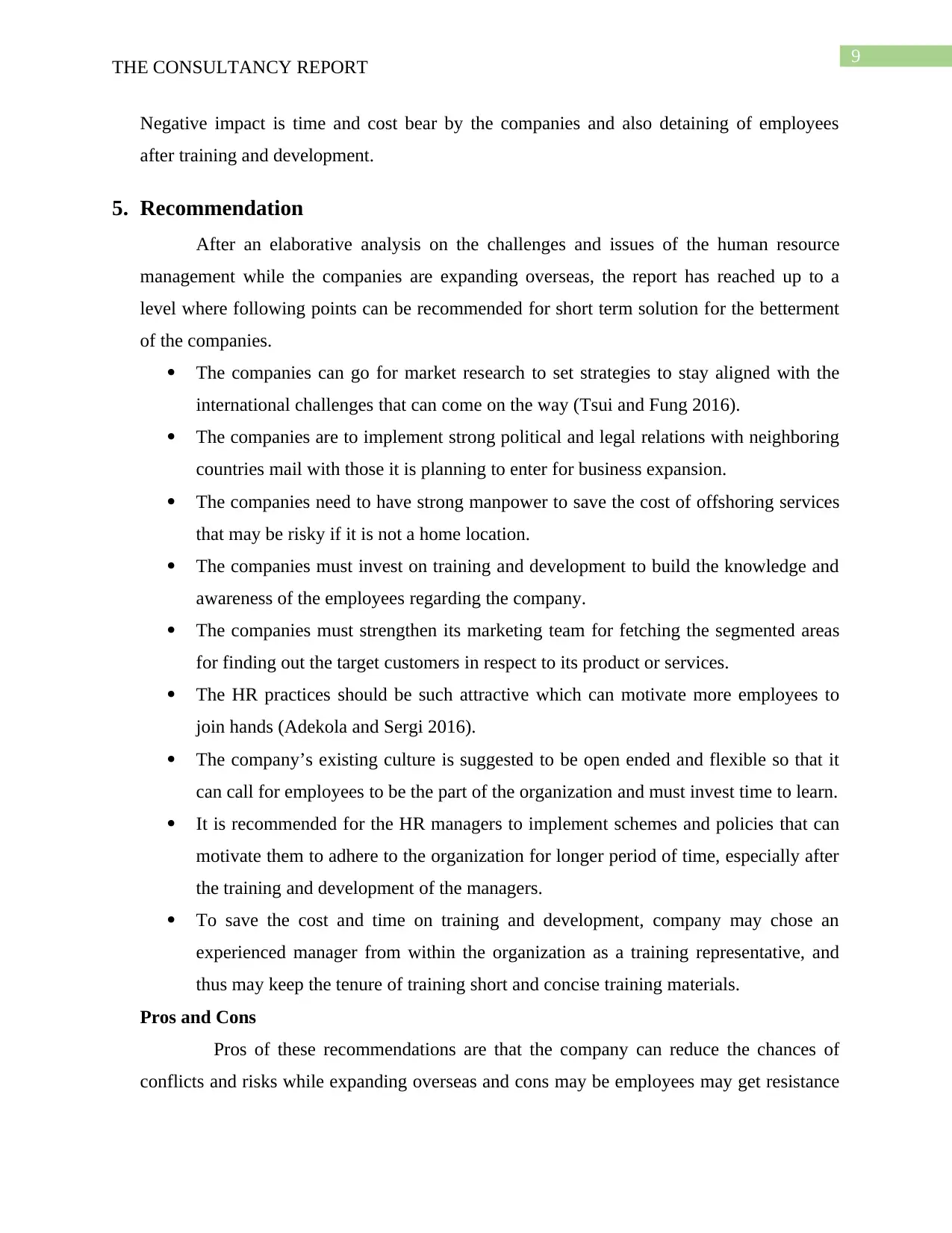
9
THE CONSULTANCY REPORT
Negative impact is time and cost bear by the companies and also detaining of employees
after training and development.
5. Recommendation
After an elaborative analysis on the challenges and issues of the human resource
management while the companies are expanding overseas, the report has reached up to a
level where following points can be recommended for short term solution for the betterment
of the companies.
The companies can go for market research to set strategies to stay aligned with the
international challenges that can come on the way (Tsui and Fung 2016).
The companies are to implement strong political and legal relations with neighboring
countries mail with those it is planning to enter for business expansion.
The companies need to have strong manpower to save the cost of offshoring services
that may be risky if it is not a home location.
The companies must invest on training and development to build the knowledge and
awareness of the employees regarding the company.
The companies must strengthen its marketing team for fetching the segmented areas
for finding out the target customers in respect to its product or services.
The HR practices should be such attractive which can motivate more employees to
join hands (Adekola and Sergi 2016).
The company’s existing culture is suggested to be open ended and flexible so that it
can call for employees to be the part of the organization and must invest time to learn.
It is recommended for the HR managers to implement schemes and policies that can
motivate them to adhere to the organization for longer period of time, especially after
the training and development of the managers.
To save the cost and time on training and development, company may chose an
experienced manager from within the organization as a training representative, and
thus may keep the tenure of training short and concise training materials.
Pros and Cons
Pros of these recommendations are that the company can reduce the chances of
conflicts and risks while expanding overseas and cons may be employees may get resistance
THE CONSULTANCY REPORT
Negative impact is time and cost bear by the companies and also detaining of employees
after training and development.
5. Recommendation
After an elaborative analysis on the challenges and issues of the human resource
management while the companies are expanding overseas, the report has reached up to a
level where following points can be recommended for short term solution for the betterment
of the companies.
The companies can go for market research to set strategies to stay aligned with the
international challenges that can come on the way (Tsui and Fung 2016).
The companies are to implement strong political and legal relations with neighboring
countries mail with those it is planning to enter for business expansion.
The companies need to have strong manpower to save the cost of offshoring services
that may be risky if it is not a home location.
The companies must invest on training and development to build the knowledge and
awareness of the employees regarding the company.
The companies must strengthen its marketing team for fetching the segmented areas
for finding out the target customers in respect to its product or services.
The HR practices should be such attractive which can motivate more employees to
join hands (Adekola and Sergi 2016).
The company’s existing culture is suggested to be open ended and flexible so that it
can call for employees to be the part of the organization and must invest time to learn.
It is recommended for the HR managers to implement schemes and policies that can
motivate them to adhere to the organization for longer period of time, especially after
the training and development of the managers.
To save the cost and time on training and development, company may chose an
experienced manager from within the organization as a training representative, and
thus may keep the tenure of training short and concise training materials.
Pros and Cons
Pros of these recommendations are that the company can reduce the chances of
conflicts and risks while expanding overseas and cons may be employees may get resistance
Paraphrase This Document
Need a fresh take? Get an instant paraphrase of this document with our AI Paraphraser
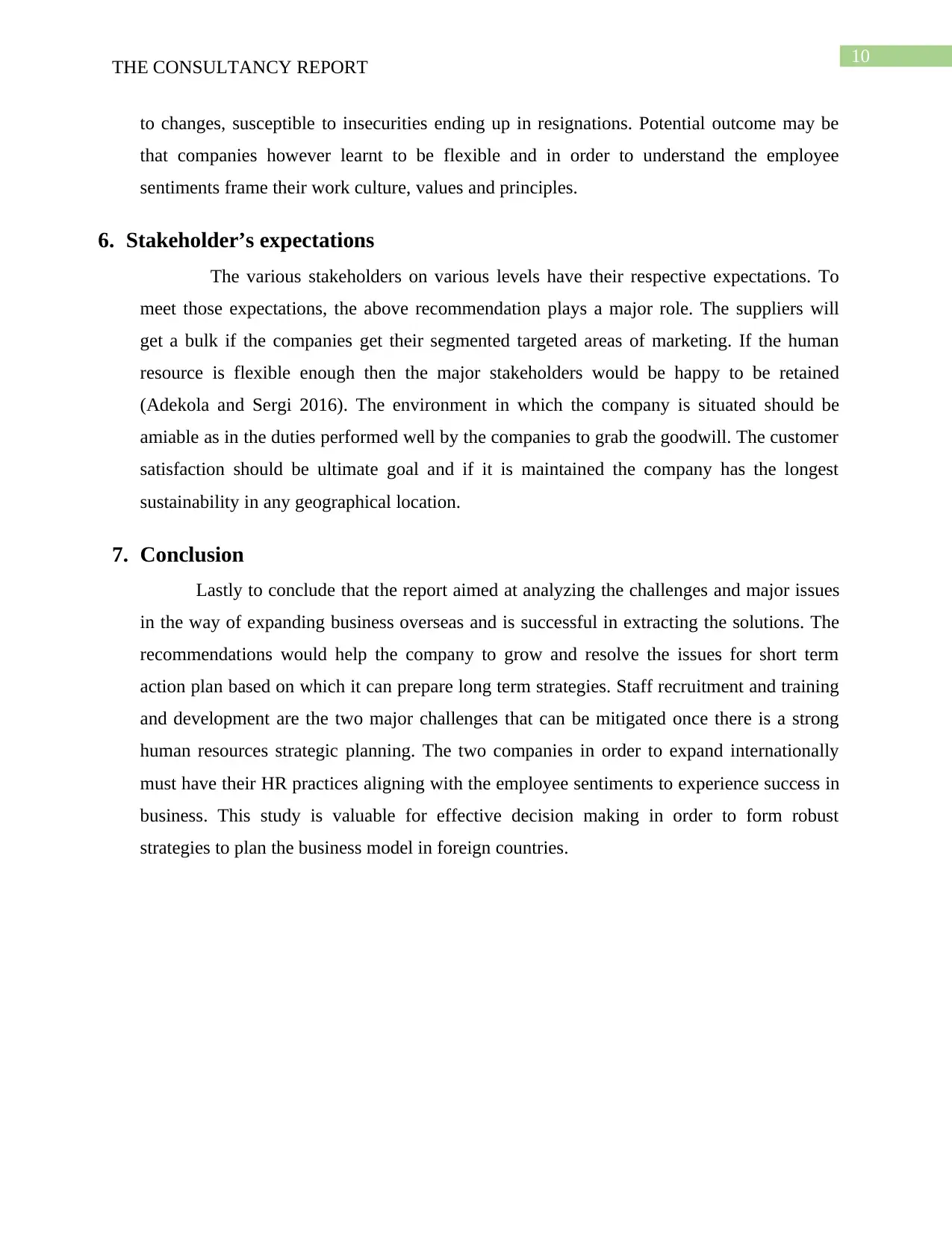
10
THE CONSULTANCY REPORT
to changes, susceptible to insecurities ending up in resignations. Potential outcome may be
that companies however learnt to be flexible and in order to understand the employee
sentiments frame their work culture, values and principles.
6. Stakeholder’s expectations
The various stakeholders on various levels have their respective expectations. To
meet those expectations, the above recommendation plays a major role. The suppliers will
get a bulk if the companies get their segmented targeted areas of marketing. If the human
resource is flexible enough then the major stakeholders would be happy to be retained
(Adekola and Sergi 2016). The environment in which the company is situated should be
amiable as in the duties performed well by the companies to grab the goodwill. The customer
satisfaction should be ultimate goal and if it is maintained the company has the longest
sustainability in any geographical location.
7. Conclusion
Lastly to conclude that the report aimed at analyzing the challenges and major issues
in the way of expanding business overseas and is successful in extracting the solutions. The
recommendations would help the company to grow and resolve the issues for short term
action plan based on which it can prepare long term strategies. Staff recruitment and training
and development are the two major challenges that can be mitigated once there is a strong
human resources strategic planning. The two companies in order to expand internationally
must have their HR practices aligning with the employee sentiments to experience success in
business. This study is valuable for effective decision making in order to form robust
strategies to plan the business model in foreign countries.
THE CONSULTANCY REPORT
to changes, susceptible to insecurities ending up in resignations. Potential outcome may be
that companies however learnt to be flexible and in order to understand the employee
sentiments frame their work culture, values and principles.
6. Stakeholder’s expectations
The various stakeholders on various levels have their respective expectations. To
meet those expectations, the above recommendation plays a major role. The suppliers will
get a bulk if the companies get their segmented targeted areas of marketing. If the human
resource is flexible enough then the major stakeholders would be happy to be retained
(Adekola and Sergi 2016). The environment in which the company is situated should be
amiable as in the duties performed well by the companies to grab the goodwill. The customer
satisfaction should be ultimate goal and if it is maintained the company has the longest
sustainability in any geographical location.
7. Conclusion
Lastly to conclude that the report aimed at analyzing the challenges and major issues
in the way of expanding business overseas and is successful in extracting the solutions. The
recommendations would help the company to grow and resolve the issues for short term
action plan based on which it can prepare long term strategies. Staff recruitment and training
and development are the two major challenges that can be mitigated once there is a strong
human resources strategic planning. The two companies in order to expand internationally
must have their HR practices aligning with the employee sentiments to experience success in
business. This study is valuable for effective decision making in order to form robust
strategies to plan the business model in foreign countries.
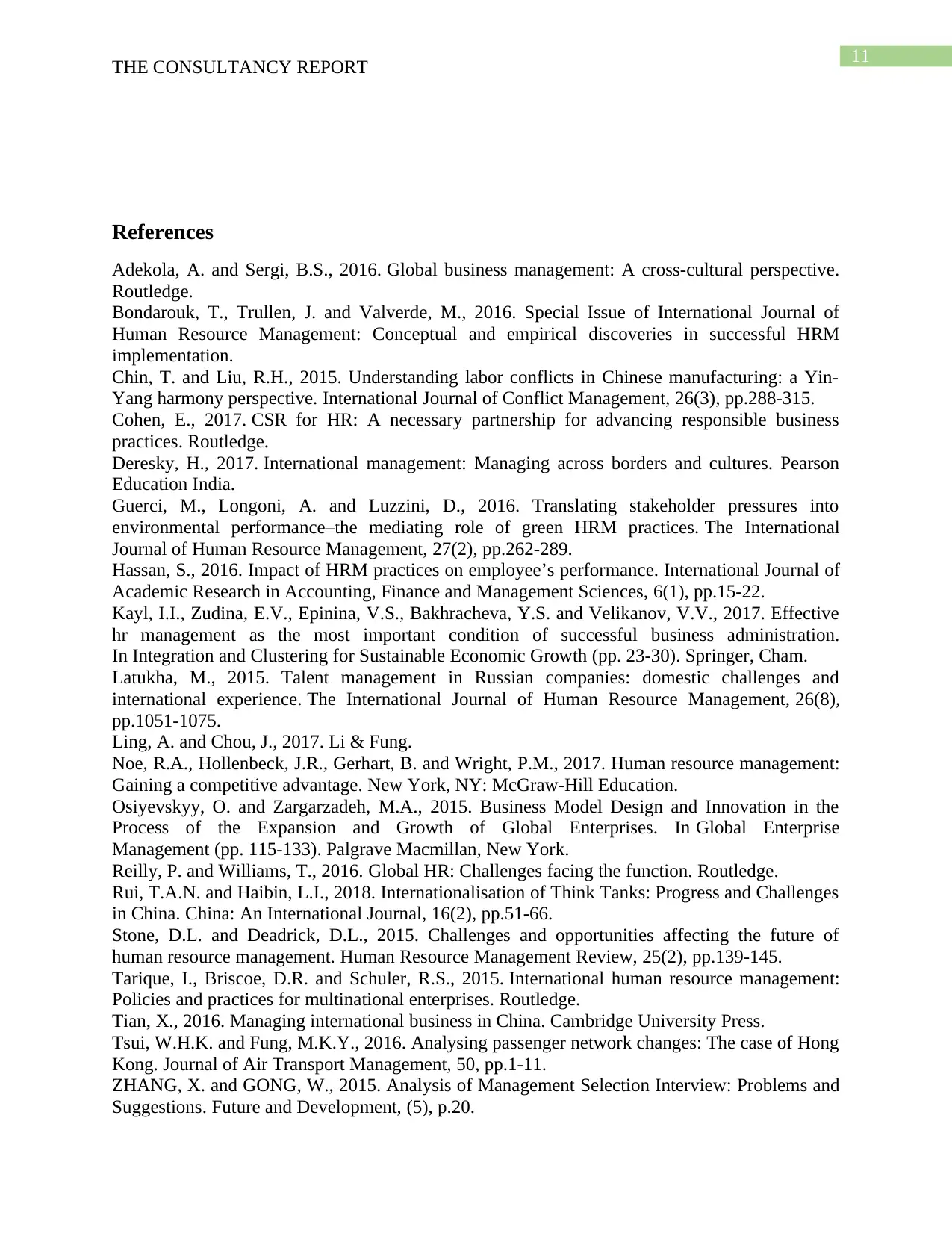
11
THE CONSULTANCY REPORT
References
Adekola, A. and Sergi, B.S., 2016. Global business management: A cross-cultural perspective.
Routledge.
Bondarouk, T., Trullen, J. and Valverde, M., 2016. Special Issue of International Journal of
Human Resource Management: Conceptual and empirical discoveries in successful HRM
implementation.
Chin, T. and Liu, R.H., 2015. Understanding labor conflicts in Chinese manufacturing: a Yin-
Yang harmony perspective. International Journal of Conflict Management, 26(3), pp.288-315.
Cohen, E., 2017. CSR for HR: A necessary partnership for advancing responsible business
practices. Routledge.
Deresky, H., 2017. International management: Managing across borders and cultures. Pearson
Education India.
Guerci, M., Longoni, A. and Luzzini, D., 2016. Translating stakeholder pressures into
environmental performance–the mediating role of green HRM practices. The International
Journal of Human Resource Management, 27(2), pp.262-289.
Hassan, S., 2016. Impact of HRM practices on employee’s performance. International Journal of
Academic Research in Accounting, Finance and Management Sciences, 6(1), pp.15-22.
Kayl, I.I., Zudina, E.V., Epinina, V.S., Bakhracheva, Y.S. and Velikanov, V.V., 2017. Effective
hr management as the most important condition of successful business administration.
In Integration and Clustering for Sustainable Economic Growth (pp. 23-30). Springer, Cham.
Latukha, M., 2015. Talent management in Russian companies: domestic challenges and
international experience. The International Journal of Human Resource Management, 26(8),
pp.1051-1075.
Ling, A. and Chou, J., 2017. Li & Fung.
Noe, R.A., Hollenbeck, J.R., Gerhart, B. and Wright, P.M., 2017. Human resource management:
Gaining a competitive advantage. New York, NY: McGraw-Hill Education.
Osiyevskyy, O. and Zargarzadeh, M.A., 2015. Business Model Design and Innovation in the
Process of the Expansion and Growth of Global Enterprises. In Global Enterprise
Management (pp. 115-133). Palgrave Macmillan, New York.
Reilly, P. and Williams, T., 2016. Global HR: Challenges facing the function. Routledge.
Rui, T.A.N. and Haibin, L.I., 2018. Internationalisation of Think Tanks: Progress and Challenges
in China. China: An International Journal, 16(2), pp.51-66.
Stone, D.L. and Deadrick, D.L., 2015. Challenges and opportunities affecting the future of
human resource management. Human Resource Management Review, 25(2), pp.139-145.
Tarique, I., Briscoe, D.R. and Schuler, R.S., 2015. International human resource management:
Policies and practices for multinational enterprises. Routledge.
Tian, X., 2016. Managing international business in China. Cambridge University Press.
Tsui, W.H.K. and Fung, M.K.Y., 2016. Analysing passenger network changes: The case of Hong
Kong. Journal of Air Transport Management, 50, pp.1-11.
ZHANG, X. and GONG, W., 2015. Analysis of Management Selection Interview: Problems and
Suggestions. Future and Development, (5), p.20.
THE CONSULTANCY REPORT
References
Adekola, A. and Sergi, B.S., 2016. Global business management: A cross-cultural perspective.
Routledge.
Bondarouk, T., Trullen, J. and Valverde, M., 2016. Special Issue of International Journal of
Human Resource Management: Conceptual and empirical discoveries in successful HRM
implementation.
Chin, T. and Liu, R.H., 2015. Understanding labor conflicts in Chinese manufacturing: a Yin-
Yang harmony perspective. International Journal of Conflict Management, 26(3), pp.288-315.
Cohen, E., 2017. CSR for HR: A necessary partnership for advancing responsible business
practices. Routledge.
Deresky, H., 2017. International management: Managing across borders and cultures. Pearson
Education India.
Guerci, M., Longoni, A. and Luzzini, D., 2016. Translating stakeholder pressures into
environmental performance–the mediating role of green HRM practices. The International
Journal of Human Resource Management, 27(2), pp.262-289.
Hassan, S., 2016. Impact of HRM practices on employee’s performance. International Journal of
Academic Research in Accounting, Finance and Management Sciences, 6(1), pp.15-22.
Kayl, I.I., Zudina, E.V., Epinina, V.S., Bakhracheva, Y.S. and Velikanov, V.V., 2017. Effective
hr management as the most important condition of successful business administration.
In Integration and Clustering for Sustainable Economic Growth (pp. 23-30). Springer, Cham.
Latukha, M., 2015. Talent management in Russian companies: domestic challenges and
international experience. The International Journal of Human Resource Management, 26(8),
pp.1051-1075.
Ling, A. and Chou, J., 2017. Li & Fung.
Noe, R.A., Hollenbeck, J.R., Gerhart, B. and Wright, P.M., 2017. Human resource management:
Gaining a competitive advantage. New York, NY: McGraw-Hill Education.
Osiyevskyy, O. and Zargarzadeh, M.A., 2015. Business Model Design and Innovation in the
Process of the Expansion and Growth of Global Enterprises. In Global Enterprise
Management (pp. 115-133). Palgrave Macmillan, New York.
Reilly, P. and Williams, T., 2016. Global HR: Challenges facing the function. Routledge.
Rui, T.A.N. and Haibin, L.I., 2018. Internationalisation of Think Tanks: Progress and Challenges
in China. China: An International Journal, 16(2), pp.51-66.
Stone, D.L. and Deadrick, D.L., 2015. Challenges and opportunities affecting the future of
human resource management. Human Resource Management Review, 25(2), pp.139-145.
Tarique, I., Briscoe, D.R. and Schuler, R.S., 2015. International human resource management:
Policies and practices for multinational enterprises. Routledge.
Tian, X., 2016. Managing international business in China. Cambridge University Press.
Tsui, W.H.K. and Fung, M.K.Y., 2016. Analysing passenger network changes: The case of Hong
Kong. Journal of Air Transport Management, 50, pp.1-11.
ZHANG, X. and GONG, W., 2015. Analysis of Management Selection Interview: Problems and
Suggestions. Future and Development, (5), p.20.
⊘ This is a preview!⊘
Do you want full access?
Subscribe today to unlock all pages.

Trusted by 1+ million students worldwide
1 out of 13
Related Documents
Your All-in-One AI-Powered Toolkit for Academic Success.
+13062052269
info@desklib.com
Available 24*7 on WhatsApp / Email
![[object Object]](/_next/static/media/star-bottom.7253800d.svg)
Unlock your academic potential
Copyright © 2020–2025 A2Z Services. All Rights Reserved. Developed and managed by ZUCOL.





